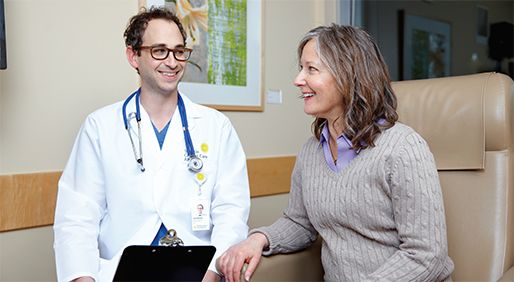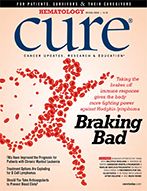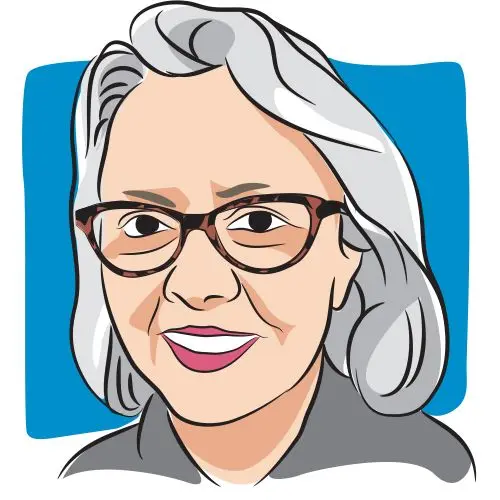Publication
Article
CURE
Treatment Options for B Cell Lymphomas Continue to Expand
Author(s):
There’s an enormous — and growing — menu of treatments for B cell lymphomas.
KAREN ALLEN meets with JOSHUA ROSENBAUM, MD, of the radiology department at the University of Washington.

KAREN ALLEN meets with JOSHUA ROSENBAUM, MD, of the radiology department at the University of Washington Medical Center.
In the spring of 2008, Karen Allen was a classic mother in perpetual motion.
Her job with the Wenatchee School District in central Washington state kept her busy enough, and in off hours, she was the designated soccer chauffeur for two daughters — “the usual hustle and bustle of a mom with teenagers,” she says. While she’d been battling fatigue for a while, she didn’t make too much of it. “When you’re really busy, you don’t focus on yourself,” she says. “You just keep plowing forward, living life, and try to have dinner on the table at 6 o’clock.”
One morning she was in the shower and discovered an alarming series of lumps running down each side of her rib cage, from armpit to waist. They hadn’t been there the night before. She was in her doctor’s office that afternoon.
The immediate concern was some indolent form of cancer — a quiet form of disease that isn’t particularly aggressive, but also doesn’t easily reveal itself. But her doctor didn’t share that worrisome hunch. Instead, Allen waited nervously over several weeks through a series of tests. The conclusion: follicular lymphoma, an uncommon blood cancer. It had likely been brewing for years, and had reached stage 4.
The management of follicular lymphoma often begins with a period of watchful waiting without immediate treatment, so despite her initial alarm, Allen had some time to learn and think. She invested in a couple of second opinions and dug into the research. She learned about the potent chemotherapy regimens that had a good track record with more aggressive forms of disease. And it sank in that, for her indolent variety, the options weren’t as promising and were less likely to be curative. It seems like a paradox, but aggressive, high-grade lymphomas, while more immediately dangerous, can be curable; meanwhile, the low-grade follicular ones, although remissions are often seen early on, are not usually curable long-term.
UW Medicine lymphoma expert
. Gopal finds that talking about lymphoma with patients can be tricky at first. Most people know that it’s not a good thing when cancer spreads to the lymph nodes, and when patients find out that it directly involves the lymphatic system, the situation seems dire from the outset. Fortunately, says Gopal, that’s not quite the case. “I don’t want to minimize the seriousness of stage 4 lymphoma,” he says, but, in fact, there are a lot of options for advanced B cell diseases. “We can still cure people that have stage 4 disease, or put it into remission.”
Finally, she visited Ajay Gopal, M.D., a
Gopal enrolled Allen in a clinical trial, an early attempt at combining fenretinide (related to vitamin A) with the antibody Rituxan (rituximab), the very first targeted therapy to gain FDA approval. The fenretinide seemed to give about one in five patients a very long remission and is being further developed, while Rituxan had already emerged as an important agent in lymphoma treatment. Allen was lucky enough to register a positive response.
“I did really well,” she says. “I hit remission and I never lost hair.” She was thrilled to avoid the side effects, and also the heavy-duty chemotherapy. But the trial results were underwhelming overall, and ultimately it was closed. Researchers delved into more promising options. Allen was treatment-free and enjoying remission, but kept reading about an alphabet soup of potential new wonder drugs. How long would it take for one of them to hit?
“Don’t pray for me,” she told a friend. “Pray for my oncologist and all those guys in the labs.”
AN ENORMOUS MENU
The National Cancer Institute (NCI) maintains an online database of drugs approved for different kinds of cancer. Some cancers have only a couple of agents available, but most have at least a half dozen. As of this writing, non-Hodgkin lymphoma boasts a relatively long list of approved drugs at approximately 30, with 10 drug combinations also commonly used to treat the disease.
The list includes older drugs like chlorambucil, a chemotherapy known as an alkylating agent, that are losing ground to the newer generation of drugs. Mainstays include Rituxan, a monoclonal antibody that works by attaching to cells marked with the protein CD20 and attracting the body’s immune system to kill them, and the specific chemotherapy combinations (abbreviated with call signs like ECHO, CHOP and R-CHOP) that work well against aggressive cases.
There are standards for the care of indolent lymphomas. According to the NCI, earlier stages are typically treated with watchful waiting or radiation (for limited-stage disease), monoclonal antibodies and/or chemotherapy. Later stages may be treated with any of those strategies or a combination thereof, or with targeted drugs known as kinase inhibitors, which interfere with enzymatic activity the cancer needs in order to grow. Bone marrow transplants come into play when initial treatment has not been effective.
But among lymphoma researchers, it’s not uncommon to hear the argument that clinical trials may provide the patient’s best treatment. “I believe that having clinical trial options gives you more (alternatives), and potentially gives you better long-term outcomes, because you basically have more choices on the menu,” says Gopal.
Two things have come together: First, a lot of new therapies have passed through initial development testing -- more than 200 drugs are currently under review. Second, many of them appear to be both more effective than existing options, and generally less toxic. “The problem is really that there are so many combinations,” says Mitchell Smith, M.D., in the Department of Hematology and Oncology at Cleveland Clinic. “It’s sometimes hard to figure out which ones to test.”
To help refine the search, scientists are focusing on following the molecular trail of cancer in patients with lymphoma, trying to tease out stopping and starting points that minimize negative side effects and maximize therapeutic impact. Lab work using mathematical modeling and mouse experiments is also being used to help determine what combinations might work best. “We’re trying to optimize our use of these drugs,” says Smith.
For more than a decade, excitement has been building over a technique that engineers a patient’s own T cells to attack a specific cancer, called chimeric antigen receptor (CAR) T cell therapy. This has finally advanced to clinical trials for the treatment of diffuse large B cell lymphoma and mantle cell lymphoma.
But the biggest buzz surrounds the many new drugs: In 2013, the U. S. Food and Drug Administration (FDA) approved Revlimid (lenalidomide), an immunomodulatory drug that strengthens the immune system while also killing the blood vessels that feed tumors; it was approved for patients with mantle cell lymphoma that had returned after treatment with Velcade (bortezomib), a drug that blocks the activity of proteasome enzymes in cancer cells, potentially killing the cells. This year, the monoclonal antibody Gazyva (obinutuzumab), in combination with an older chemotherapy agent, bendamustine (discovered in 1963 but approved for lymphoma in 2008), was approved for the treatment of relapsed follicular lymphoma. Both bendamustine and obinutuzumab are currently being tested with numerous other agents in dozens of clinical trials.
The universe of drugs in the later stages of clinical trials is even wider: Arzerra (ofatumumab), a monoclonal antibody targeting the CD20 protein on cancer cells, has also shown potential in treating B cell non-Hodgkin lymphoma, such as follicular lymphoma, diffuse large B cell lymphoma and Waldenström’s macroglobulinemia. Adcetris (brentuximab vedotin) is a monoclonal antibody already approved for Hodgkin and anaplastic T cell lymphoma treatment. In Adcetris, the antibody locks onto the CD30 molecule of a cancer cell and then delivers a potent drug that tampers with cell division and growth, disabling the cell. Each of these drugs is being tested in dozens of open trials, in a wide variety of combinations, against non-Hodgkin lymphoma. Venclaxta (venetoclax), a BCL-2 inhibitor (already approved in CLL, a cousin to non-Hodgkin lymphomas), reinstates the ability of cancer-damaged cells to kill themselves (a process known as apoptosis); it’s also being tested against non-Hodgkin lymphoma, as are dozens more agents.
Perhaps the most talked-about new options are Imbruvica (ibrutinib) and Zydelig (idelalisib), kinase inhibitors that block enzymes that contribute to B cell proliferation. In 2014, the FDA granted Zydelig accelerated approval to treat patients with relapsed follicular lymphoma. However, six trials of Zydelig in combination with other drugs were put on hold in March due to severe toxicities. The drug remains available for its approved indications, though, including as a monotherapy for relapsed follicular lymphoma.
Imbruvica, meanwhile, is now being tested in dozens of non-Hodgkin lymphoma trials. It was first approved by the FDA in November 2013 for the treatment of mantle cell lymphoma when two-thirds of patients in a single trial saw their disease shrink or disappear altogether. In 2014 it gained wider use for the treatment of CLL. In January of 2015, it was approved for treatment of the B cell lymphoma Waldenström’s macroglobulinemia; cancer shrank in 62 percent of trial participants. Most recently, in March of 2016, Imbruvica was approved as a first-line treatment for CLL.
Common side effects of Imbruvica include low blood platelet counts (thrombocytopenia), a decrease in infectionfighting white blood cells (neutropenia), diarrhea, low red blood cell counts (anemia), lack of energy (fatigue), musculoskeletal pain, bruising or bleeding, nausea, upper respiratory tract infection, irregular heartbeat and rash.
What excites researchers is finding a combination punch that cures the cancer without doing too much collateral damage to the patient. “We want to develop a regimen up front that is safe and tolerable and is potentially curative,” says Bruce D. Cheson, M.D., head of hematology at Georgetown University Hospital. “I think that a chemofree approach to patients with B cell malignancies is realistic. But it takes a better understanding of the biology, immunology and genetics. And it takes, most importantly, participation in clinical trials to achieve that goal.”
“Until we are curing our patients with no toxicity, a clinical trial is the standard of care,” he argues. “In my mind, the best thing we can do for our patients is to improve their first therapy for their disease. To do that, we have to have an understanding of how the disease changes over time. Your best chance is your first chance.” The number of drug options is both good and bad, he says. “The potential for doublets and triplets is staggering,” he says, and complicated even further when combined with what we’re learning about the differences between patients and disease types. “We have to recognize the tremendous diversity amongst patients and exploit that to improve efficacy and reduce toxicity.”
While companies are developing similar drugs, they are not identical. The perfect combination punch might include a drug from both companies A and B. “In the best of all possible worlds, you could get whichever drug you wanted based on sound scientific rationale and combine it with something else,” says Cheson. “We’re still working on that.” That’s one reason researchers are hesitant to name favorites in this race. Another is their sense that we’re still at least five years from putting everything together into a cure. With more than 200 active clinical trials in B cell non-Hodgkin lymphoma and nearly 400 more just getting started, excitement may be high, but the jury is out.
CAREFUL DECISIONS
There was no particular moment when Allen realized that her follicular lymphoma had mounted a comeback. It was caught during a regular blood screening, when she returned to Seattle and Gopal to review her options. Gopal suggested enrolling in another clinical trial, this time for Imbruvica. Allen was excited when she realized that Imbruvica was one of the drugs with the alphabet soup call signs she’d been reading about over the last few years. “This research is not going at glacial speeds,” she thought. “It is so breathtakingly inspiring.”
But it was not a pleasant start — beginning with a persistent case of diarrhea. “This has got to resolve, because it’s pretty miserable,” she thought. Then, a couple of weeks in, she awoke with a full body rash. They pulled her off the drug, then restarted it a couple of weeks later. The rash never reappeared, but the diarrhea remained. “It was a struggle for months,” she said, though she’s been able to manage it with diet. When the two-year trial ended last spring, she enrolled in the follow-up trial without reservation.
Gopal appreciates the power of Imbruvica, especially for patients like Allen, but has his concerns, as well. For example, a confirmatory trial for Imbruvica compared it to chlorambucil in untreated CLL. “That is like comparing it to something only somewhat better than saline,” he says. “Of course it’s going to be a positive trial. The FDA let the drug companies get away with studies that don’t address the clinically relevant questions.” Yet, once approved, companies aggressively market their drugs, and patients ask doctors about using them.
Some patients should get Imbruvica right off the bat while others can get chemotherapy and Rituxan and have years, perhaps as much as a decade, of disease control. That is certainly better than experiencing long-term toxicity and expenses associated with years of ibrutinib, Gopal says.
With such a diverse armamentarium, how do you decide? Different doctors have different styles. Some are dogmatic, always giving agents in precise order. Gopal, on the other hand, tries “to individualize it to the patient.” Pre-existing conditions can guide treatment choice, as can a patient’s preference regarding side effects. Treatment history matters, too. If a patient had long remissions with chemotherapy combined with Rituxan, then perhaps another round of the same will give them a longer time off of treatment.
“These are very long discussions,” Gopal says, and it’s important to have a doctor who sees a lot of patients with your disease and has a focused interest. “I believe that having clinical trial options gives you more options and potentially gives you better long-term outcomes, because you basically have more choices on the menu. You’ve got the off-the-shelf choices that you can get anywhere, and then you have the clinical trial choices,” he says. “It’s a really exciting time in terms of the options we have for our patients, though we still clearly have a lot of work to do.”
“I really enjoy being a clinical trial patient,” adds Allen. She loved the team effort, and knowing that she played a role. “Having this kind of diagnosis is crummy, but if I can give back in any way, I’m glad to,” she says.
Researchers often need extra tissue to study, and it’s very hard to come by. “I always say ‘yes,’” Allen says, “because somebody else before me said ‘yes,’ as well.”





